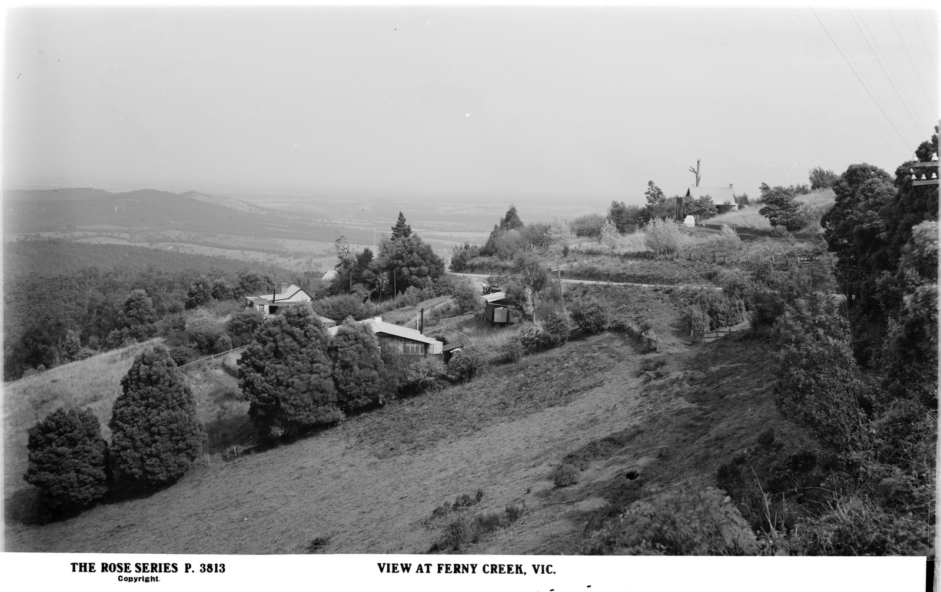On the 30th of March in 1918, while the so-called Great War was raging in Europe, there was a land auction on the Holly Hill Estate in the Dandenongs. The land was owned by William Breen and the auction conducted by Coghill and Haughton, respectable auctioneers based in the city, 42 kilometres to the west. Being offered was land from 0.5 acre to 2.0 acres that the brochure proclaimed as being suitable for Mountain Homes, Health Resort Homes, Weekend Bungalows, Camping Sites, Horticulture Purposes, and Intense Culture Farming.
Seventy six allotments were offered and the local newspapers called the auctioneers brave for offering land more than 4 miles from the closest train station (now called Upper Ferntree Gully). Unfortunately for Breen, only twenty-six blocks sold and these were located on View Hill Road, now called Hilton Road. View Hill Road offered relatively flat blocks with amazing views across to the city and the bay. Views that I would enjoy over 100 years later from our humble mountain home from our upper deck. I would stand on the deck with a drink and a special cigar and watch the lights flicker over the endless Melbourne suburbs. It was a majestic view and I fell wonderfully above the bleak sameness of the city yet part of it, soaring above the valley.
Somehow Australians can only make sense of their own sense of place by referring to a place in Europe or the United States and we joked that we were living in the Hollywood Hills of Melbourne. Somehow, I doubt they talk about the Dandenongs views in the Hollywood Hills.
Breen named one of the streets on his estate Breen Terrace in a wonderfully grandiose gesture that is repeated today as land holders sell farm land on the edge of the city to build new exurbs. Kilometres of gigantic new houses without a tree, school, or playground in sight. The only difference is that today a developer is not brave for building a development a long distance from a train line. It’s expected. That’s what cars are for.
Slightly adjacent to the Breen estate was a large block of land that was bought by the 1920s entrepreneur, Sidney Myer who in the 1920s built a grand house and private golf course. We had dinner there a few years ago with the current owner who served stale beer and sported a healthy moustache and touchy hands, particularly with women. We only went once. It was enough.
My wife has an uncle who has spent his entire 85 years living in the Victorian goldfields. He is enamoured by the local history and has collections of odds and ends, coins, axe handles, guns; he calls them relics. When he speaks of the “pioneers” his eyes glaze over and his voice softens. They are his people. That pioneer is a loaded term and a nice way of saying occupier does not concern him. He longs to be close to the freshness and possibility and hardship of a new country. Gold, land, and the promise of wealth in the Southern land. There is a very short distance from the lie of terra nullius and a pioneer poisoning waterways and handing out smallpox infected blankets to the first peoples.
Travelling from the city to look for houses in the late naughts, we felt like pioneers, driving through the suburban badlands from the inner city to the hills was an adventure, a journey of discovery to a region with forests, crappy Devonshire teas, bushfires, and The Family, a homegrown cult that gave children LSD and psilocybin and God knows what else. Every third house we looked at had a spa or a weird altar to Gaia or the occult. Time had stopped since the eighties and people would wave when you drove down the gravel roads. ‘That’s weird’, we would say, ‘we don’t know them’.
Now we wave at everyone. It feels good.
After the 1962 bushfires which killed 33 people and burned 450 homes the local government instituted a buyback scheme for hills dwellers that lived on the steep western face of Breen’s development. The allotments that failed to sell in 1918 were bought back and turned into forest and the streets turned into tracks. The roads became tracks and the houses ghost houses quickly enveloped by trees, shrubs, and grasses. A reminder that our time here is temporary and foolish. The indigenous communities lived in the hills for 35,000 years and the white folk could barely survive 50 years, expelled by fire and the consequence of developer greed.
Today, Ferny Creek is a small community inhabited by white middle-aged people. The Australian Bureau of Statistics reports that the average age is 45 and just 1% of residents are indigenous. There is a predominance of comfortable SUV’s and the newer residents are concerned about rising house values just as Breen was more than 100 years ago. He would be proud of his creation.
Sources:
- http://www.coxhill.com/basinhistory/basinhistoryphotosmaps.htm
- https://viewer.slv.vic.gov.au/?entity=IE7116847&mode=browse
- https://victoriasforestsbushfireheritage.com/2022/04/03/dandenong-ranges-buyback-scheme/

